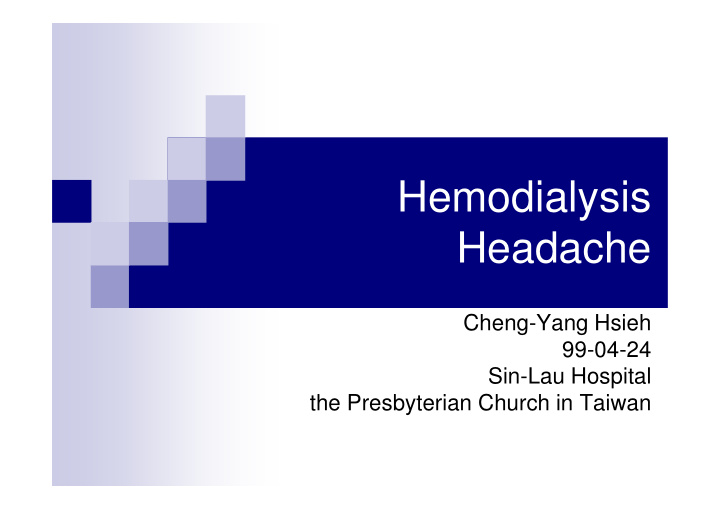



Hemodialysis Headache Headache Cheng-Yang Hsieh 99-04-24 Sin-Lau Hospital the Presbyterian Church in Taiwan
Outline � Introduction of hemodialysis headache � Epidemiology � Review of clinical researches � Review of clinical researches � Potential pathophysiology � Prospective: to investigate hemodialysis headache in Taiwan
Introduction � End-stage renal disease in Taiwan 1,2 � Incidence: 331/million � Ranked first in the world (2002~2005) � Ranked first in the world (2002~2005) � Prevalence: 1322/million � Ranked second in the world (2002~2005) � More than 90% ESRD patients received hemodialysis (HD) 1. Nephro Dial Transplant, 2008 2. Acta Nephrologica, 2007
Introduction � Complications of hemodialysis (HD) � Acute: agitation, delirium, muscle cramps, convulsions, headache , irritability � Chronic: Wernicke’s encephalopathy, dementia, amyloid neuropathy, etc � Headache: one of the most frequently encountered neurological symptoms during HD
1. Headache 1972. Epidemiology 2. Cephalalgia 1988. � Frequency: reported to be 70% 1 � International Headache Society (HIS) criteria 2 : � Headache with onset during HD � Terminates within 24 hours after HD � Terminates within 24 hours after HD � Occurs during at least half of HD and at least thrice � Can be prevented by changing dialysis parameter � Revised in 2004
� Study design: cross-sectionalStudy Study design: cross-sectionalStudy Subjects: � ESRD patients, HD > 6 months � Setting: single hospital � Questionnaire (validation? Measurement bias?)
� Dialysis headache: more frequent in women
Summary � HD-related headache: � Prevalent among patients receiving HD � Female preponderance � Beginning after some hours of therapy � Moderate intensity � Throbbing character � Related to � Difference of pre- and post-treatment urea level � Pre-treatment blood pressure
Questions… � Hemodialysis vs. headache � Impotency vs. hypertension in men � Pre-existing headache? � Pre-existing headache? � Headache patients were prone to HD? � Headache worsen by HD? � de novo headache after initiating HD? � Related to HD procedure itself � Case selection, exclusion criteria?
� Study design: cross-sectional or “prospective”? � Setting: 3 HD institution � Subjects: ESRD patients (Jan, 1998~Dec, 1999) � Subjects: ESRD patients (Jan, 1998~Dec, 1999) � Exclusion: HD<6 mo; dementia; inability to communicate � Interviewed by one of the authors (A.L.A.)
� Randomly evaluated 123 patients from a total 741 of potential subjects � Ever experienced headache: n=83 (70.7%) *Now still experiencing headache: n=63 (51.2%) *HA during sessions: n=50 *HA between sessions: n=13
Headache after regular HD � Headache not fulfilled criteria of dialysis headache � Headache fulfilled criteria for dialysis headache, but with antecedent primary headache � Headache fulfilled criteria for dialysis headache, but without antecedent primary headache � i.e. “true” and “pure” dialysis headache
Controversies… 1. N Engl J Med , 1976 � Raskin and Fishman reported 1 : � Patients with migraine could experience clinically identical headache durign or clinically identical headache durign or following HD � And 20% of patients without previous headache could experience them in association with dialysis � The pain is bilateral and throbbing
1. Neurol Clin , 1996 Controversy… 2. Kidney Int , 1982 � These headache may disappear following renal transplant, and return if rejection occurs 1 � Some authors argue 2 � HD headache should not be classified as a distinct diagnostic entity � HD itself is simply a nonspecific stress factor that induces headache
� Study design: observational, comparative � Subjects: ESRD patients with regular HD � Subjects: ESRD patients with regular HD � Exclusion: history of primary headache; having focal neurologic abnormalities; malnutrion; chronic diarrhea; need TPN; alcoholism � Questioned about quality of headache � Patients without headache as control
Potential Pathophysiology � Abrupt decrease of blood urea level � Not cause a similar concomitant decrease in the brain due to blood-brain barrier � Osmotic gradient develops Osmotic gradient develops � Water shifts into the brain � Results in an increased intracranial pressure � “reverse urea effect” � Others � Hypotension, Mg level
Am J Kidney Dis 2001
Method and study design � Cross-sectional or “prospective” � Four HD centers in Serbia � Subjects: HD patients, not mentioned � Subjects: HD patients, not mentioned inclusion and exclusion criteria � Interviewed by a neurologist � Total 318 patients included � Hemodialysis headache: 21 (6.6%)
Conclusion � Headache is common in patients undergoing HD � Living chronically with an uncomfortable � Living chronically with an uncomfortable and tedious procedure in order to remain alive � Also too often suffer the additional discomfort of recurrent headache
Perspective � The prevalence of HD is high in Taiwan � Further study of HD headache in Taiwan is warranted warranted
Thanks for your attention! attention!
Recommend
More recommend